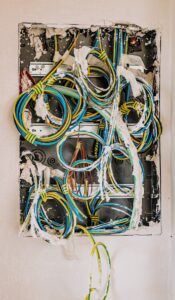Enhancing IoT Integration with Middleware
The Importance of Middleware in IoT Systems
Middleware plays a pivotal role in the successful integration of IoT systems within a global retail network. By acting as an intermediary layer, middleware enables seamless communication between various IoT devices and existing IT infrastructure. For business executives, mid-level managers, and entrepreneurs in Saudi Arabia, UAE, Riyadh, and Dubai, understanding the benefits of middleware is crucial for optimizing IoT deployments and ensuring business success.
Middleware serves as a bridge that facilitates data exchange and interoperability between diverse IoT devices and applications. In the context of a global retail network, middleware simplifies the complex process of integrating numerous IoT sensors, RFID tags, and smart devices with central management systems. This integration is essential for real-time inventory tracking, supply chain management, and enhancing customer experiences. By providing a unified interface, middleware ensures that data flows smoothly across all connected devices, enabling efficient monitoring and control.
Streamlining Operations with Middleware
One of the key advantages of using middleware in IoT integration is the ability to streamline operations. Middleware solutions offer robust data processing capabilities that aggregate, filter, and analyze data from various IoT endpoints. For instance, in a large retail chain with stores across Riyadh, Dubai, and other cities, middleware can collect data from smart shelves, POS systems, and customer feedback terminals. This data is then processed to provide actionable insights, helping managers make informed decisions about inventory levels, promotional strategies, and customer service improvements.
Middleware also enhances scalability and flexibility. As a retail network expands, middleware allows for the easy addition of new IoT devices and systems without disrupting existing operations. This scalability is vital for businesses looking to grow and adapt to changing market demands. By leveraging middleware, retailers can quickly integrate new technologies and stay ahead of the competition. Additionally, middleware supports various communication protocols, ensuring compatibility between legacy systems and modern IoT devices, which is essential for maintaining a cohesive and efficient IT ecosystem.
Ensuring Security and Compliance
Security is a critical concern in IoT integration, especially for global retail networks that handle sensitive customer data and financial transactions. Middleware solutions incorporate advanced security features to protect data integrity and privacy. For example, middleware can encrypt data transmitted between IoT devices and central systems, safeguarding it from unauthorized access and cyber threats. In regions like Saudi Arabia and the UAE, where data protection regulations are stringent, middleware ensures compliance with local and international standards.
Moreover, middleware provides robust access control mechanisms that restrict data access to authorized personnel only. This is particularly important in retail environments where multiple stakeholders, including suppliers, logistics providers, and store managers, need access to different data sets. By implementing role-based access controls, middleware helps prevent data breaches and ensures that sensitive information is handled securely. This enhances customer trust and protects the business’s reputation.
Implementing Middleware for Effective IoT Integration
Choosing the Right Middleware Solution
Selecting the appropriate middleware solution is a crucial step in successful IoT integration. Businesses must consider various factors, including compatibility with existing systems, scalability, and ease of use. Middleware solutions should support a wide range of IoT protocols and standards to ensure seamless integration with diverse devices. For a global retail network, middleware that can handle high data volumes and provide real-time analytics is essential.
Organizations should also evaluate the middleware’s ability to support future growth and technological advancements. As IoT technologies evolve, middleware should be flexible enough to incorporate new features and functionalities. This future-proofing ensures that the investment in middleware continues to deliver value over the long term. Additionally, middleware solutions with user-friendly interfaces and robust support services can significantly reduce the complexity of IoT integration, enabling faster deployment and minimizing downtime.
Case Study: Middleware in a Global Retail Network
A leading global retail network successfully integrated IoT systems using middleware to enhance operational efficiency and customer experience. The retailer, with stores in major cities like Riyadh and Dubai, faced challenges in managing a vast array of IoT devices, including smart shelves, RFID tags, and customer feedback kiosks. By implementing a comprehensive middleware solution, the retailer achieved seamless data exchange and real-time analytics across its entire network.
The middleware aggregated data from various IoT endpoints, providing centralized visibility into inventory levels, customer preferences, and store performance. This enabled the retailer to optimize stock levels, reduce waste, and improve product availability. Additionally, the middleware facilitated personalized customer interactions by analyzing feedback and purchase history, allowing the retailer to tailor marketing campaigns and promotions. The successful integration of middleware not only streamlined operations but also enhanced the overall shopping experience, driving customer satisfaction and loyalty.
Overcoming Integration Challenges
While the benefits of middleware in IoT integration are significant, businesses may encounter challenges during implementation. These challenges can include compatibility issues with legacy systems, data integration complexities, and the need for extensive customization. To overcome these hurdles, businesses should adopt a phased approach to IoT integration, starting with pilot projects to test the middleware’s capabilities and gradually scaling up.
Engaging experienced IoT and middleware consultants can also help navigate integration challenges. These experts can provide valuable insights and best practices for optimizing middleware deployment. Additionally, ongoing training and support for IT staff ensure that they are equipped to manage and maintain the integrated IoT systems effectively. By addressing potential challenges proactively, businesses can maximize the benefits of middleware and achieve successful IoT integration.
Conclusion
Middleware plays a vital role in the successful integration of IoT systems within global retail networks. By enabling seamless communication, streamlining operations, and ensuring security, middleware enhances the efficiency and effectiveness of IoT deployments. For businesses in Saudi Arabia, UAE, Riyadh, and Dubai, leveraging middleware is essential for optimizing IoT integration and achieving business success. By selecting the right middleware solution and addressing integration challenges strategically, organizations can unlock the full potential of IoT technologies and drive innovation in the retail sector.
—
#IoTIntegration #Middleware #GlobalRetailNetwork #SmartTechnology #BusinessSuccess #LeadershipSkills #ProjectManagement #ArtificialIntelligence #SaudiArabia #UAE #Riyadh #Dubai













